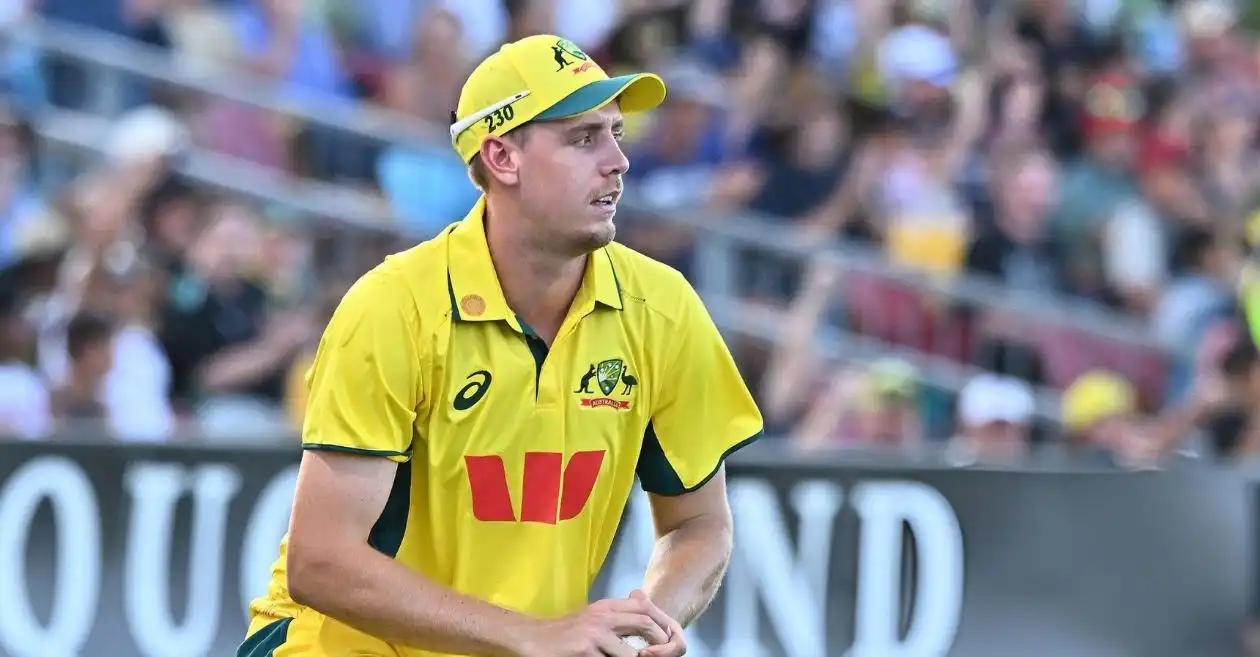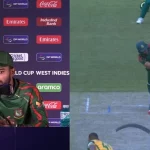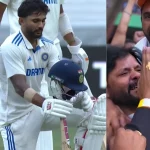As Australia gear up for their much-anticipated three-match ODI series against India starting October 19, they’ve been dealt an early setback — one that could have significant implications for both their short-term white-ball campaign and long-term Test ambitions. Dynamic all-rounder Cameron Green has been ruled out of the series due to side soreness, forcing selectors to reshuffle the squad just days before the opening fixture in Perth.
The series, which runs from October 19 to 25, is not just another bilateral affair — it’s a key preparatory platform for both cricketing giants ahead of a packed international calendar that includes the home summer for Australia and India’s upcoming away challenges. But with Green sidelined, Australia’s balance and tactical approach suddenly look a lot more complicated.
Green’s Absence: A Major Setback in Balance and Depth
In the modern era, few Australian cricketers have risen as rapidly as Cameron Green. The 25-year-old has carved out a niche as one of the rare all-format all-rounders capable of influencing games with both bat and ball. His tall frame, clean ball-striking, and steady seam bowling have often provided the perfect cushion for a team that thrives on flexibility.
However, Cricket Australia confirmed on Friday that Green has been ruled out of the ODI series against India after complaining of side soreness during a training session. While the injury has been categorized as “low grade,” the medical team has opted for a precautionary approach, mindful of the bigger picture — particularly the Ashes 2025–26, which remains central to Australia’s long-term plans.
“Green will complete a short period of rehabilitation and is tracking to return to play in round three of the Sheffield Shield to continue his preparation for the Ashes,” Cricket Australia said in a statement.
This decision reflects Australia’s cautious management of their premium all-rounder, especially given his recent history of injuries. It also highlights how pivotal Green has become to the team’s red-ball aspirations, with selectors unwilling to risk even minor setbacks that could jeopardize his availability for the Test summer.
A Timeline of Green’s Comeback Journey
Green’s current setback comes almost a year after undergoing back surgery in October 2024, a procedure that had sidelined him from competitive cricket for several months. His comeback was carefully managed through the domestic circuit, culminating in his recent participation in the Sheffield Shield, where he bowled a controlled four-over spell and even picked up a wicket.
That outing was viewed as a promising sign of his return to full fitness, but the recurrence of discomfort has prompted an immediate pullback.
Sources close to the Australian camp suggest that Green’s latest injury is not related to his previous back surgery. Instead, the “side soreness” is believed to be a minor strain aggravated during training. However, the management’s decision to rest him underlines the high value placed on his fitness and longevity.
Green’s rehabilitation will now continue in Perth, with a target of returning for Western Australia’s next Sheffield Shield match on October 28 — just days after the ODI series concludes in India.
Why Green’s Absence Matters
Australia’s ODI setup has relied heavily on the balance Green provides. Batting in the middle order, he offers both stability and acceleration, while his medium-fast bowling gives the team a crucial sixth bowling option — particularly in conditions where frontline pacers may struggle with workload.
Without him, Australia will be forced to rethink their team composition, especially since Mitchell Marsh, the newly appointed ODI captain, also operates as a batting all-rounder who often manages his own bowling workload carefully.
Green’s versatility was on full display earlier this year during Australia’s home season and the 2025 T20 World Cup preparations, where he often chipped in with economical overs and handy cameos lower down the order. His absence not only affects team balance but also the psychological edge Australia often enjoy through their depth.
Marnus Labuschagne Returns as Replacement
To fill the void left by Green, Australia have recalled Marnus Labuschagne — a name synonymous with relentless energy, consistency, and technical excellence. Labuschagne’s recall marks a significant turnaround in his white-ball fortunes after being initially omitted from the original ODI squad.
Selectors cited his red-hot domestic form as the key reason for his inclusion. The Queensland batter has been in sublime touch, registering four centuries in recent domestic matches — two of them in the 50-over format — reaffirming his credentials as a reliable top-order option.
Labuschagne’s inclusion offers Australia solidity rather than like-for-like balance. While Green brings an all-round option, Labuschagne provides a more traditional batting anchor. This shift could see Australia lean on part-timers such as Travis Head or Matthew Short to compensate for the missing overs.
The 30-year-old right-hander, however, will view this recall as a fresh opportunity to cement his white-ball place, especially after enduring a lean patch earlier in the year when he scored just two single-digit knocks against South Africa.
“Marnus has shown great hunger and form at the domestic level. His adaptability in the middle order gives us a solid backup option as we manage workloads and injuries,” a Cricket Australia selector noted in an internal release.
Squad Adjustments: Multiple Changes Ahead of First ODI
Green’s withdrawal isn’t the only shuffle in Australia’s lineup. The touring squad has seen a few last-minute changes due to injuries and personal reasons:
-
Josh Philippe, the dynamic wicketkeeper-batter from Western Australia, has been drafted in to replace Josh Inglis, who is still recovering from a calf strain.
-
Adam Zampa, the team’s premier leg-spinner, will miss the first ODI due to family reasons but is expected to rejoin the squad from the second match onwards.
-
Senior wicketkeepers Alex Carey and Josh Inglis are also set to be available from the second ODI, which should stabilize the team composition moving forward.
These alterations mean that the opening ODI in Perth will see a slightly experimental Australian side — one that blends experience with youth and flexibility.
Updated Australia ODI Squad
Mitchell Marsh (c), Xavier Bartlett, Cooper Connolly, Ben Dwarshuis, Nathan Ellis, Josh Hazlewood, Travis Head, Matthew Kuhnemann, Marnus Labuschagne, Mitchell Owen, Josh Philippe, Matthew Renshaw, Matthew Short, Mitchell Starc, Adam Zampa (from 2nd ODI), Alex Carey (from 2nd ODI), Josh Inglis (from 2nd ODI)
Key Talking Points Before the Series
1. Mitchell Marsh’s Leadership Test
With Pat Cummins rested and Steve Smith sitting out, the ODI captaincy falls on Mitchell Marsh — a player who’s quietly emerging as one of Australia’s most respected leaders. This series presents an opportunity for Marsh to showcase his tactical acumen and ability to motivate a relatively young squad under challenging conditions.
Marsh’s leadership will be crucial in balancing workloads among fast bowlers, managing inexperienced middle-order options, and ensuring Australia remain competitive despite missing key players like Green and Zampa (for the first ODI).
2. The All-Rounder Equation
Without Green, Marsh may have to rely on Matthew Short or Cooper Connolly to share part-time bowling duties. Alternatively, Australia might consider playing an additional seamer — someone like Nathan Ellis or Ben Dwarshuis — depending on pitch conditions.
This could also mean a heavier batting responsibility on Travis Head and Marnus Labuschagne, especially if the team opts for an extra bowler at the expense of batting depth.
3. India’s Challenge on Home Soil
Facing India in their own backyard is never easy. The Men in Blue, led by Rohit Sharma, have been nearly unbeatable in ODIs at home, combining spin dominance with power-hitting depth. For Australia, acclimatizing quickly to subcontinental conditions — slower pitches, higher humidity, and varied bounce — will be key.
The visitors’ pace attack, spearheaded by Mitchell Starc and Josh Hazlewood, will have to find early breakthroughs, while spinners like Kuhnemann and Zampa (once available) will play defining roles through the middle overs.
Green’s Long-Term Focus: The Ashes Looms Large
While fans may be disappointed to see Green miss the India ODIs, the decision underscores a broader strategic outlook. Australia’s medical staff and selectors are prioritizing Green’s long-term red-ball readiness, particularly with the Ashes 2025–26 approaching rapidly.
After his back surgery, Green has been on a carefully monitored workload management plan, ensuring his return doesn’t lead to chronic injuries. His role in the Test setup — as a middle-order batter and fourth seamer — remains pivotal, especially as Australia prepare to defend the urn on home soil next year.
The plan is for Green to complete a short rehabilitation phase before returning to Western Australia’s Sheffield Shield side, where he’ll continue building match fitness through multi-day cricket. If all goes as planned, he’ll be ready for Australia’s summer Test series starting in December.
Marnus Labuschagne’s Redemption Arc
For Marnus Labuschagne, this recall could be a career-defining moment in white-ball cricket. Despite his dominance in Tests, he’s struggled to translate that consistency into ODIs, where strike rotation and adaptability under pressure are key.
However, his domestic form suggests a renewed sense of purpose. Over the past month, Labuschagne has adopted a more positive batting tempo, working on improvisation and range-hitting — skills that could finally help him bridge the gap between formats.
If he performs well in this series, Labuschagne could solidify his spot as a reliable top-order anchor in the lead-up to future white-ball tournaments.
Australia’s Road Ahead
This ODI series against India is only the beginning of a demanding stretch for Australia. Following the India tour, they will dive headfirst into their home summer, featuring Pakistan and West Indies across formats before shifting focus to Ashes preparation in early 2026.
For head coach Andrew McDonald and the selection panel, this period is all about balancing workloads, fine-tuning combinations, and nurturing fringe players who can seamlessly step up when required.
Players like Xavier Bartlett, Matthew Renshaw, and Matthew Short will be eager to make their mark, while veterans such as Starc and Head will aim to guide the younger brigade through subcontinental challenges.
What Green’s Absence Means Strategically
Beyond the numbers, Green’s absence changes Australia’s tactical blueprint. Without his dual skill set, Marsh and the team management might:
-
Play an extra specialist batter to strengthen the middle order.
-
Use Travis Head and Matthew Short as part-time bowling options.
-
Opt for a seam-heavy attack led by Starc, Hazlewood, and Ellis.
-
Depend on spin variation from Kuhnemann and Short until Zampa rejoins.
It also means that Australia might take a slightly conservative approach with the bat, especially during middle overs, where Green’s acceleration was often pivotal.
India vs Australia — The Stage Is Set
Despite the setbacks, Australia’s upcoming ODI series against India remains one of the most anticipated clashes of the season. The rivalry carries historical weight, strategic intrigue, and immense fan appeal. For both sides, it’s more than just preparation — it’s a statement of intent.
India, buoyed by home advantage and depth across departments, will look to maintain dominance. Australia, on the other hand, will aim to prove their adaptability, resilience, and bench strength in the absence of a key player.
And while Cameron Green’s absence may momentarily unsettle Australia, it also opens the door for others — like Marnus Labuschagne — to step forward and shape the narrative.
Cameron Green’s injury might have disrupted Australia’s immediate plans, but it’s a prudent call in the broader scheme of things. With the Ashes 2025–26 looming and a long international calendar ahead, Australia’s focus on player longevity and sustainable workload management is both strategic and necessary.
As the series kicks off on October 19 in Perth, all eyes will be on how the visitors regroup, how Marnus Labuschagne fits into the setup, and whether Mitchell Marsh’s men can overcome early adversity to script a memorable series against a full-strength Indian unit.
Please check for information on the best betting sites in India – https://selectory.org/best-betting-sites/















